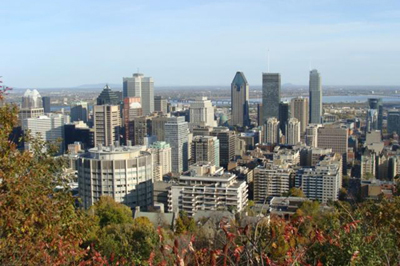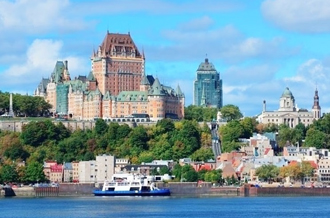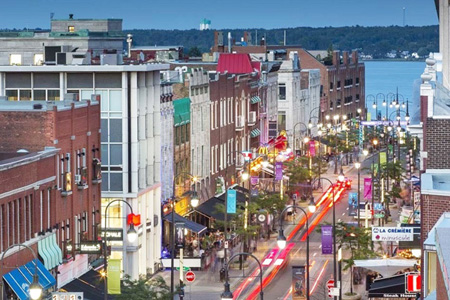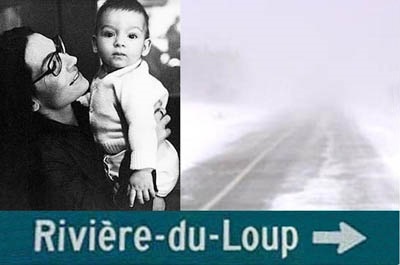 |
|
Quebec is one of the places that marked Nana’s beginnings. This fact, little known, is probably explained by its distance from Europe where she began her career. Indeed, what a surprise, at that time, to learn that her French songs were hits somewhere in North America. Quebecers who discovered her bought her records and went to see her regularly in concert. Nana came so often that she has developed a nice complicity with the public. While wandering our open spaces, she discovered our main cities and regions as well as our songs.
|
|
|
THE QUEBECERS
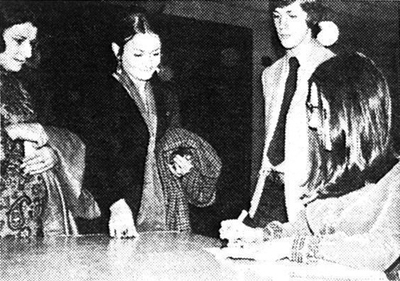 |
Nana defines herself as a stage performer. Beyond her recordings, she finds essential to perform in front of an audience. Also, during years, after each concert, she took time to receive spectators in order to talk, sign autographs and be photographed with them. Of course, at the beginning, Nana could hardly understand French from here. So she had to get used to our accent and our expressions so different as those used in France. "faire à souper" (to prepare the dinner), "magasiner" (to go shopping), "endisquer" (to record), "B-S" (welfare), "achalant" (annoying), "long jeu" (long play) and "frigidaire" (refrigerator) are typical terms to which Nana quickly became familiar. She likes to come back in our homeland and appreciates Quebecers which she describes as direct and simple. She finds them welcoming, gentle and friendly.
|
Autograph session after a concert.
OUR OPEN SPACES
Like most of European people, Nana is used to a high concentration of population. When she travelled through our roads to give her concerts, she realized the wideness of our open spaces. Nana came to Quebec at all the times of the year. She was surprised by our extremes temperatures: our intense cold and our moist heats. Snowstorms forced her to delay or to defer her concerts and she even had to buy an umbrella because of the gloomy weather. She also knew Indian summer, the one sung by Joe Dassin. This season which only exists in North America occurs sometimes in the middle of autumn when mercury reaches summery temperatures during several consecutive days. And of course, she admired our autumn landscapes with a mixture or green, yellow and red leaves. Altogether, Nana sang in 28 different cities and had the opportunity to celebrate her birthday on stage three times: in Sorel, in Rivière-du-Loup and in Montreal. At the time of her tours through the Province, she couldn’t visit a lot because she moved every day. On the other hand, she knows very well Montreal and Quebec City because she went back there often and ran during a whole week.
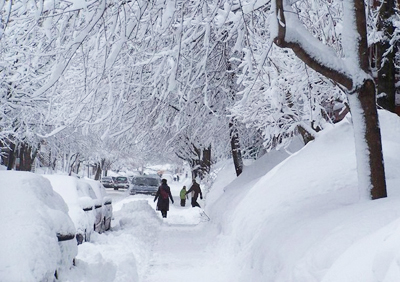
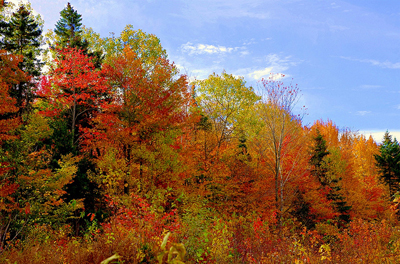

During her many stays, Nana could see the contrast of our landscapes according to the seasons and to celebrate her birthday.
MONTREAL
Montreal, the second French-speaking city in the world, represents her entry gate in Quebec. Nana mentions it in two of her songs: "C’est mon histoire" (Je chante en Irlande, en Finlande ou bien à Montréal) and "Danny come home" (In a town near Montreal) and must consider it as one of the stategic cities of her beginnings in America. Her first visit in May 1965 confirmed that some of her songs were known here. During the press conference given in honor of the show presented with Harry Belafonte, Nana admitted that she liked the metropolis. She said that it reminded her of Athens precisely because of Mount Royal which is in the center of the city like the Acropolis plateau.
|
|
Montreal seen from Mount Royal.
From her various hotel rooms, Nana has seen the downtown area from every angle. When she has time, Nana likes to walk in Old Montreal. There we find many historical buildings, museums as well as fine dining restaurants. Located in the heart of it, the City hall. It was from its balcony that General de Gaulle, then President of the French Republic, said: «Vive le Québec libre!» (Long live Quebec!). In 1995, Nana was invited to sign the guest book in the presence of the mayor of the time, Mr. Pierre Bourque. Nearby is the Old Port which stretches over two kilometers. The view from the observation tower of Notre-Dame-de-Bon-Secours Chapel inspired the chansonnier Leonard Cohen for his poem "Suzanne". By recording the song in 2002, Nana became the 24th artist to refer to the statue of the Virgin facing the river : (Comme du miel, le soleil coule sur Notre-Dame-des-Pleurs - And the sun pours down like honey on our lady of the harbor).


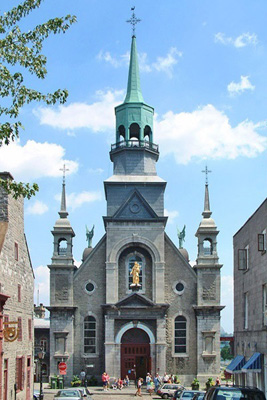
Montreal City Hall, the Old Port and Notre-Dame-de-Bon-Secours Chapel.
She also knows the downtown streets that any pedestrian takes pleasure to walk. There is Saint-Denis street renowned for its numerous cafés, terraces, restaurants, bookshops and specialized shops. In 1995, Nana was there to give two concerts in the famous theater of the area. And Sainte-Catherine street where there is the highest concentration of stores. For more than 11 km length, it’s the largest commercial artery in the country. Nana also had the opportunity to go in the underground city which connects several buildings by tunnels till the metro stations. The 35 kilometers underground passageways enable to walk sheltered from the cold and the snow without dressing winter clothing.
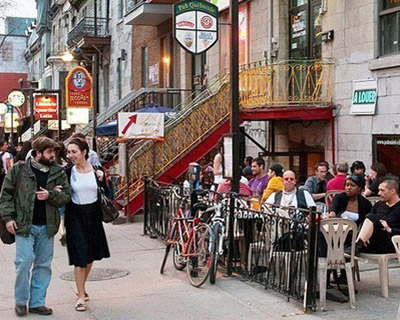
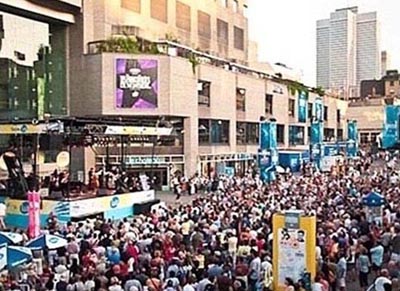
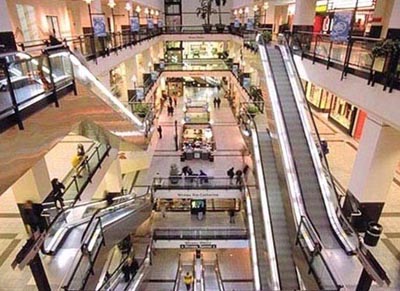
Saint-Denis street and its terraces, Sainte-Catherine street during festival time and a complex of the underground city.
Nana is aware that Montreal is a city of festivals whether it be the one of Music, Film, Theatre, Dance, Literature and of Sports. During the summer, the most famous are the International Jazz Festival, Just for Laughs and the one of FrancoFolies in which Nana participated in 2004. For a number of years, during the summer season, streets sections are closed in order to allow the pedestrians to circulate freely.
 |
For Montrealers, entertainment is omnipresent; at the Bell Centre, the Casino, in the theaters and the concert halls. The largest one, Salle Wilfrid-Pelletier, was named in honour of the famous conductor. It's the hall in the world where Nana gave more concerts after Olympia of Paris. Composed of 3,000 seats, it lays out a vast stage which lends itself to all kinds of shows. Nana also performed at Théâtre Maisonneuve and at Maison symphonique. The three halls are part of Place des Arts.
|
Photomontage before the Place des Arts.
In that cultural complex is also located the Musée d'art contemporain, the first museum in the country entirely devoted to modern art. Its numerous temporary exhibitions allow to beat attendance records. During the 2017-2018 season, for example, the one on Leonard Cohen attracted more than 300,000 people. Nana was one of them. It is with contemplation and emotion that she visited the six rooms dedicated to the artist.
|
|
The Musée d'art contemporain de Montréal.
 |
The metropolis has four universities; two Francophones (the one of Montreal and the one of Quebec) and two Anglophones (Concordia and McGill). On May 30, 2013, McGill University convened her to the annual ceremony of the Convocation of Arts and Religious Studies. On that occasion, she was awarded a doctorate "honoris causa" for her contribution to music and her social and humanitarian commitment.
|
Nana at McGill University in 2013.
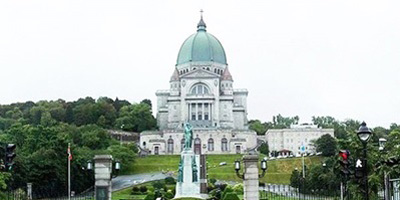
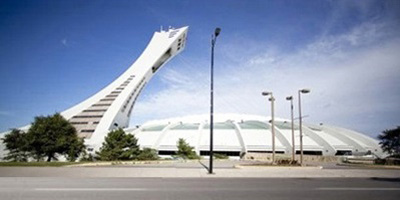
Saint Joseph's Oratory and the Olympic Stadium.
Saint Joseph's Oratory and the Olympic Stadium are favorite places. The site of the Oratory was inaugurated at the initiative of Brother André in 1904 on Mount Royal. Completed in 1967, the Oratory attracts each year about two million pilgrims from everywhere. Its dome dominates the city and its cross is the highest point of Montreal.
Built especially for the 1976 Summer Olympics, the Olympic Stadium is recognized worldwide for its unique architecture. Its creator, Roger Taillibert, has designed the tallest inclined tower. The stadium, which can accomodate 65,000 spectators, hosted for several years the baseball team The Expos. Today, it is used for sporting competitions and thematic exhibitions.
QUEBEC CITY
After Montreal, Quebec City is the town where Nana spent more time. She first performed at the Palais Montcalm, then at the Grand Théâtre and at Colisée. In the Old Capital, more unilingual, French singers are more popular. Founded in 1608, Quebec City is both the oldest town and the cradle of French civilization in North America. For its beauty and its European style, it attracts the interest of many tourists who want to visit a distinct site from the remainder of the continent.
Old Quebec, inscribed on World Heritage List by UNESCO, is a familiar place for Nana. During her many stays, she often bordered the alleys to admire the buildings dating from the French Regime and she familiarized herself with various corners of the city. Whether it be the Terrasse Dufferin, a promenade adjoining to Château Frontenac, an imposing luxury hotel which dominates the city. From there, we have a splendid panorama of the Saint Lawrence River and a bird's eye view of the Lower Town. Or also Place d'Youville, located at Porte St. Jean gate, where there are many activities. In summer, music festivals are presented and in winter a skating rink is laid out at this place.
|
|
Quebec City seen from the ferry.
The first time that Nana went there, in 1967, she crossed Bonhomme Carnaval (the festival's mascot) on her way. At the same time, she was amazed in front of the impressive Palais de Glace and the numerous sculptures. The Quebec Winter Carnival is the world’s largest winter festival. Each year, thousands of tourists travel to admire the various snow and ice constructions, to attend the night parade and to take part in the activities.
The largest shopping mall in Quebec, les Galeries de la Capitale, is among the other places that Nana visited. Its indoor amusement park is the second most important in North America. Nana sang at Telethon Opération Enfant Soleil.
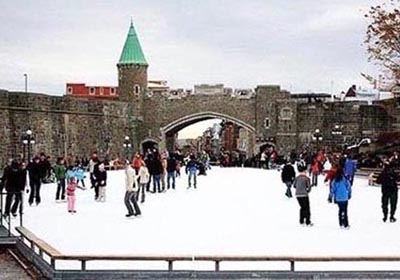
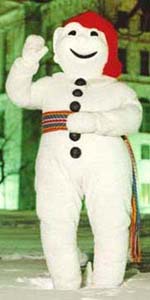

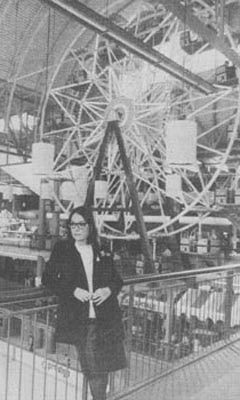
Place d'Youville in winter, Bonhomme Carnaval, the Palais de Glace in 1967 and Nana in Galeries de la Capitale.
How can it be possible to talk about Quebec City without mentioning the Parliament Building declared the first historical site? The imposing Neo-Renaissance building welcomes every year thousands of visitors. Along its facade, 26 bronze statues recall the various episodes of our history. The interior is composed of two main rooms. The Blue Room, where 125 members sit during the proceedings of the National Assembly. And the Red Room which is used for the parliamentary committees and the swearing-in ceremonies. On May 28, 2013, the Prime Minister, Mrs. Pauline Marois, received Nana in that room. She was promoted to the rank of officer of the National Order in recognition of her bounds created with Quebec and for her participation to promote our culture while singing many of our tunes.
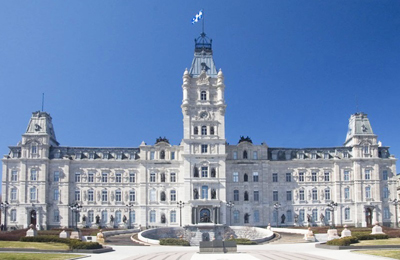
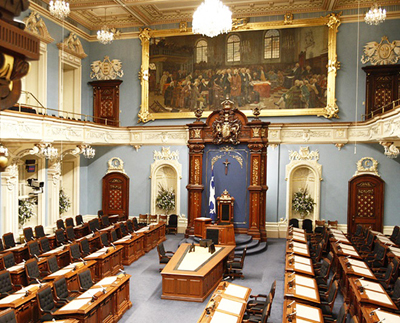
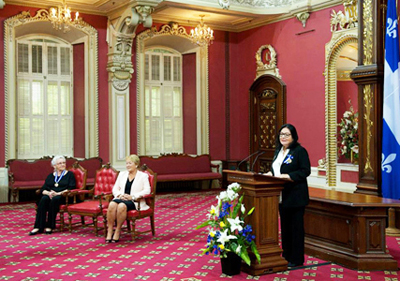
The main facade of the Parliament Building, the National Assembly Chamber and the Red Room when Nana was decorated.
In the months following the ceremony, her name was engraved in stone with the other members of the National Order of Quebec. The monument, titled Nos regards se tournent vers la lumière (Our eyes turn to Light), is the work of the sculptor Roland Poulain. It is located in the heart of the Samuel-De Champlain Promenade, a park along the St. Lawrence River.
.

The monument of National Order of Quebec and Nana's name engraved in stone.
OTHER CITIES
In addition to the two main cities, Nana occasionally visited Sherbrooke, Saguenay and Trois-Rivières where she gave various concerts.
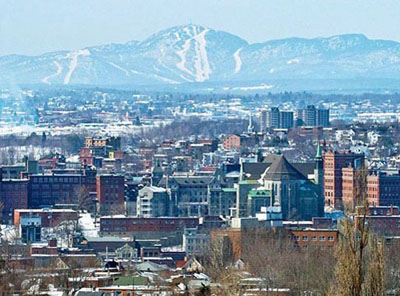 |
SHERBROOKE
During her 11 visits in Sherbrooke, she performed at Granada, at Séminaire St-Charles and at the Palais des Sports. Among the 13 concerts she presented, nine took place at the Centre Cultural of the University. The Maurice-O'Bready hall, the fourth biggest one in Quebec, was formerly known as the Grande Salle.
Located in the heart of a hilly area, Sherbrooke offers a picturesque landscape. Surrounded by lakes and many rivers the city has many green spaces. Its typical architecture recalls the one of New England. Sherbrooke has the largest concentration of students in the province.
|
Sherbrooke and Mont Orford.
SAGUENAY
Nana went six times to Saguenay (formerly known Chicoutimi). To get there from Quebec City we need three hours and we cross Réserve faunique des Laurentides. In that immence national park very popular for hunting and fishing lovers it is possible to practice a multitude of summer and winter sports. As it is a protected territory, during years, checkpoints were set up at its entries. Informations about the vehicle and the passengers were noted, and their speed was controlled. Nana remembers that it wasn’t possible to cross it during the night because the barriers at the ends were closed. The road, essentially mountainous, sinuous and not very enlightened is often crossed by mooses. At that time, the road was more dangerous and there were only two ways.
Saguenay is situated along the river bearing the same name. It is the result of the amalgamation of various municipalities of which Jonquière, Chicoutimi and La Baie in 2002. Since her first visit in 1967, Nana gave 10 concerts; at the Auditorium Dufour, at the Centre Georges-Vézina and at the Théâtre du Palais Municipal.
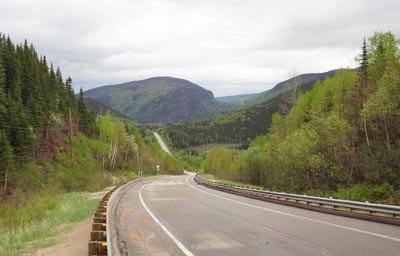
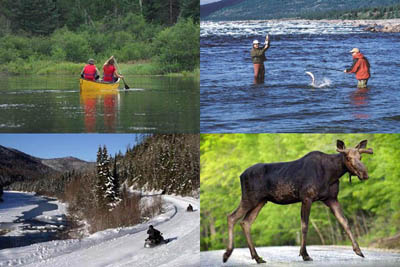
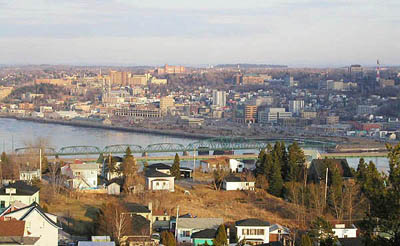
We need three hours and we cross Réserve faunique des Laurentides before getting to Saguenay.
TROIS-RIVIÈRES
Trois-Rivières is another important city. All Quebec and French artists perform there. Nana gave six concerts (in 1967, 1969, 1970, 1972, 1982 and 1999); five at Salle J. Antonio-Thompson (Capitol) and one at the Colisée de Trois-Rivières. The Trifluvians haven’t seen her so often, probably because they live halfway between Montreal and Quebec City, and because she was demanded in many other Canadian cities.
Trois-Rivières, second oldest municipality in the country, has much to offer to the tourists who wish to discover it: the Sanctuaire Notre-Dame-du-Cap, the Forges du Saint-Maurice, its various museums and of course the lively Des Forges street.
|
|
Des Forges street in Trois-Rivières
THREE REMOTE REGIONS
During her 34 stays in Quebec, Nana has visited 14 of the 17 major regions, of which three are remote: Côte-Nord, the Bas-Saint-Laurent and Abitibi-Témiscamingue.
 |
CÔTE-NORD
In 1969 and 1970, during her two longest tours, Nana had the opportunity to visit Côte-Nord. She performed in Hauterive (now merged with Baie-Comeau) and in Sept-Îles. Located above the 50th parallel North, that one has long been the last city connected by the road 138. During her first visit, Nana flew by herself to join her son Nicolas who had remained in their Montreal apartment with his nanny. Meanwhile, her musicians stayed in Baie-Comeau for a snowmobile ride before taking the ferry from Forestville to Rimouski.
|
The road 138 on the North Coast.
BAS-SAINT-LAURENT
Nana went in that area during her four tours in the Province, between 1967 and 1972. She performed at the Centre civique de Rimouski, Foyer Patro, the Centre Culturel de Rivière-du-Loup and at Collège de Matane. She returned in 1982, during an arena tour. This time at the Colisée de Rimouski.
Nana keeps a clear memory of her coming in 1969. She was in Montreal to celebrate her son's first birthday and she had to leave for Rimouski for a concert. But her flight was canceled because of a forecasted snowstorm. So that she arrived on time, her impresario drove her to Quebec City where a taxi had to take her to their destination. But as from this moment, the road conditions worsened more and more and the visibility was reduced. So the driver installed chains on the tires and they kept on driving to Rivière-du-Loup. From there, Nana should travel by the train but transportation was interrupted. As the concert was finally deffered, she stayed one night at the hotel. Her team joined her the following day for the concert who took place in the same city.
|
|
Tough return after Nicolas' birthday.
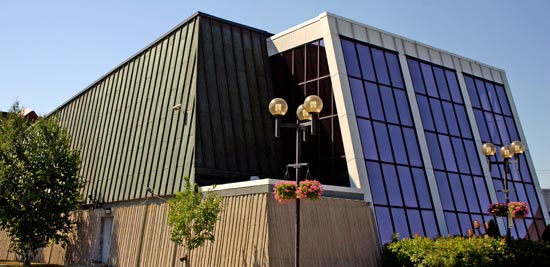 |
ABITIBI-TÉMISCAMINGUE
Located in the western part of the province, Abitibi-Témiscamingue owes its development mainly through its gold and copper mines. To get there, it’s a seven-hour-drive from Montreal. By plane, it takes a little more than an hour. In 1995, Rouyn-Noranda, the main city, hosted Nana. In a single evening, she performed in front of 1,450 Abitibians who gathered for two concerts at Théâtre du Cuivre.
|
Théâtre du Cuivre
OUR SONGS
During one of her first tours Nana discovered the folksong "Le curé de Terrebonne", a city where she has never been. In 1975, she decided to record it. It was hard because it is necessary to follow the tempo by articulating well the words. Nana sang it in a TV show by incarnating a young girl confessing herself before the priest and on stage in duet with her drummer. Each time, the number made laugh. Most of us remember more having her singing "Un Canadien errant", a lament telling the deportation of many patriots. Her adaptation of "Je reviens chez nous" in seven languages by Jean-Pierre Ferland did not go unoticed. Nana also added songs by the McGarrigle Sisters, Leonard Cohen, Roch Voisine, Daniel Lavoie and Gilles Vigneault to her repertory. Let us note that most of these titles are on the CD "Un Canadien errant / A Canadian Tribute". Nana already declared that Quebecers brought a lot to the French music.
|
|
A collection of her Canadian songs.
Since her first coming in 1965, Nana became attached to our part of the country and its people. She keeps nice memories of what she visited. Beyond unforgettable evenings spent in front of the public, she enjoyed our folklore and covered songs from several our song writers. But above all, every time she comes back, Nana feels like home. Furthermore, if we string together all her stays here, we see that Nana spent a year of her life in Quebec.






